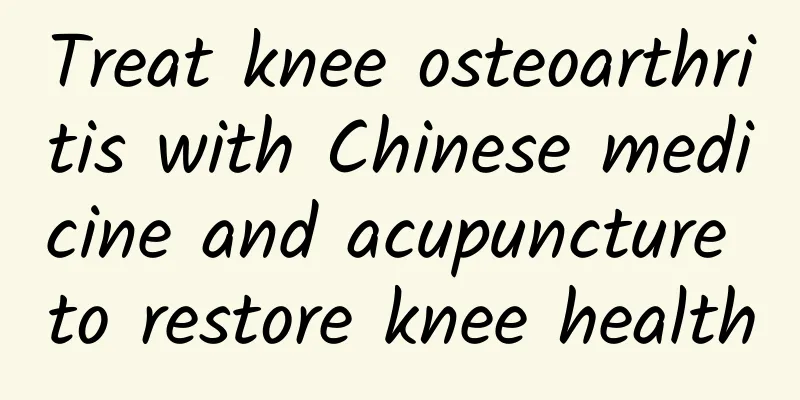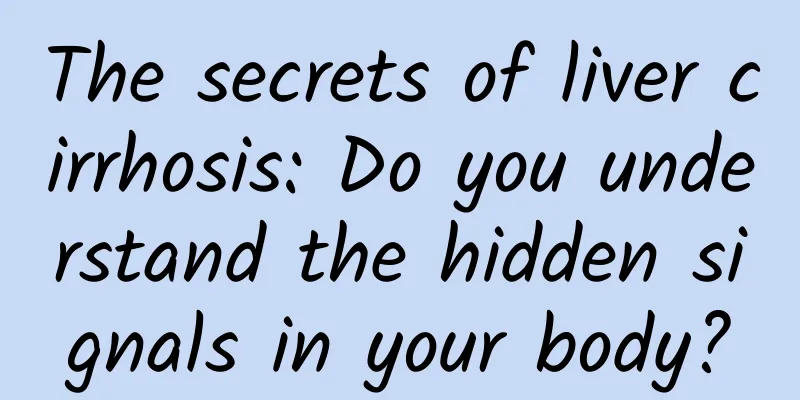Treat knee osteoarthritis with Chinese medicine and acupuncture to restore knee health

|
Knee osteoarthritis is a common chronic joint disease. The cartilage of the joint tissue becomes fibrotic, ulcerated or lost, eventually leading to bone and joint diseases. The occurrence of this disease is closely related to many factors such as age, trauma and inflammation. The patient has pain, tenderness, swelling and movement disorders in the knee joint. Combined with the current domestic situation, knee osteoarthritis has a great impact on the lives of the elderly. Long-term illness can also cause other diseases, so how to treat osteoarthritis? Generally speaking, the knee joint has been gradually going downhill since young, which is closely related to the long-term weight-bearing and wear of the knee joint. Generally speaking, the knee joint is subjected to long-term repeated wear and overuse, and some patients have abnormal knee development, trauma, or congenital deformities, which will increase the incidence of knee osteoarthritis. If the patient is too obese, it will increase the load-bearing capacity of the joint and accelerate the onset of osteoarthritis. If you have diabetes, the incidence of the disease will also increase. Studies have found that the incidence of this disease in women is higher than that in men. This may be related to endocrine disorders in women after menopause. If a family member suffers from knee osteoarthritis, the risk of the disease will increase, and the disease is somewhat hereditary. After a patient suffers from knee osteoarthritis, the quadriceps muscle strength will decrease. This article popularizes the treatment of knee osteoarthritis with traditional Chinese medicine and acupuncture. See below for details: 1. The pathogenesis of knee osteoarthritis. From the perspective of traditional Chinese medicine, knee osteoarthritis belongs to the category of arthralgia and bone arthralgia in traditional Chinese medicine. Traditional Chinese medicine treatment is mainly based on syndrome differentiation and treatment. Currently, the "Standards for Diagnosis and Efficacy of TCM Diseases and Syndromes" are often used as the basis for treatment. It is specifically divided into three types: kidney deficiency and marrow deficiency, yang deficiency and cold coagulation, and blood stasis. From the perspective of traditional Chinese medicine osteopathy, the disease is further divided into pathogenic syndrome, deficiency syndrome, and blood stasis syndrome. The use of traditional Chinese medicine to treat knee osteoarthritis should be systematically analyzed in combination with the patient's physical condition and the unique characteristics of the disease, to clarify the patient's syndrome type and provide targeted treatment. 2. Treatment methods. Common treatment methods include fumigation, compresses, hot ironing and Chinese medicine ion introduction. Chinese medicine fumigation mainly provides hot compress fumigation for the damaged knee joint of the patient through drugs. Raw rhubarb, radix spatholobi, spatholobi, ternate lanceolate, bone-setting stalk, cyathula capitata, turmeric, pangolin, clematis, angelica, cassia twig and other drugs can be used. The amount of medicinal materials can be appropriately increased or decreased according to the actual situation of the patient. The method of fumigation first and then washing is adopted to promote blood circulation and improve pain. When using Chinese medicine compresses, castor beans and fresh shepherd's purse can be selected according to the patient's symptoms, and then mashed and applied to clean gauze, and then applied to the affected area, and covered with plastic film and tied tightly. Change it once a day. During this period, attention should be paid to the skin condition. If allergic reactions occur, it should be stopped. This prescription can relieve the patient's pain and improve knee joint movement disorders. 3. Acupuncture treatment methods 3.1 Needle acupuncture Combined with meridian acupoints, patients are provided with filiform needle treatment. As a "bi syndrome", knee osteoarthritis is related to the influence of wind, cold and dampness on the limbs, which leads to poor flexion and extension of joints, pain in muscles and bones, soreness or heaviness. Severe patients will experience swelling and deformation. The filiform needle acupuncture can achieve the goals of activating collaterals, relieving pain, dispelling wind and cold, and removing dampness. Select the patient's Dalun point and Xiyangguan point, pierce the center of the selected point straightly, and open two needles 1 inch on both sides to the center obliquely. The needle should be retained for 20 minutes. This can improve the patient's tolerance and relieve the patient's pain. 3.2 Needle Fire Sting Take the patient's Futu, Yanglingquan, Yinlingquan, Neixiyan, Waixiyan, Zusanli, Liangqiu, Xuehai, and Xiyangguan points and use fire needling method. The needle retention time is 30 minutes, and the needle should not be moved during the retention process. 4. Moxibustion From the perspective of traditional Chinese medicine, knee osteoarthritis is caused by the invasion of wind, cold and dampness. The heat of moxibustion can penetrate into the muscle layer to warm the meridians, remove dampness and relieve pain, and have the effects of warming the meridians, removing dampness and cold, and promoting qi and blood circulation. Patients are provided with moxibustion for treatment. The inner and outer knee joints and the Shi acupoints of the patient are selected for moxibustion once a day, each time for 10 minutes, and the treatment is five times a week. This treatment can reduce the HA concentration in the patient's blood. 5. Warm acupuncture The heat of moxibustion fire is used to warm the meridians, remove dampness and cold, and promote qi and blood circulation. It makes up for the insufficiency of simply providing acupuncture for patients. The inner and outer knee points of the patient are selected as the main acupoints, and Zusanli and Shenshu points are selected as auxiliary acupoints. For patients with kidney deficiency and marrow deficiency type knee osteoarthritis, the needle retention time is half an hour each time, and the treatment is six times a week. Two 2-section moxa sticks are used each time, and the patient is needled once during the process of changing the moxa stick. This treatment method can effectively relieve the patient's pain, walking discomfort or morning stiffness symptoms, so that the patient's suffering can be alleviated. 6. Blood-pricking and cupping therapy This treatment mode can effectively improve the patient's blood circulation and the internal environment of the knee joint, inhibit bone hyperplasia, and achieve the purpose of preventing and treating knee osteoarthritis. Through Dong's extraordinary acupoint pricking and cupping treatment, the patient's Jinban, Jinji, and Jinling acupoints are used. For left-sided diseases, the right acupoint is used, for right-sided diseases, the left acupoint is used, and for bilateral lesions, both sides are used. The patient is guided to sit in a prone position, and a disposable three-edged needle is used to pierce the acupoint with a depth of 2-5mm. The needle is immediately removed, and the glass jar is adsorbed on the acupoint using the flash fire method. The cupping time is 10-15 minutes, and bleeding from the cupping area is ensured, with an amount of 1-2ml. 7. Acupuncture knife therapy Acupuncture knife treatment not only achieves the effect of acupuncture, but also can effectively loosen and dissolve adhesions of soft tissue injuries around the knee, scrape and remove scars, and cut them, so as to restore the patient's biomechanical balance, relieve the patient's pain level, and effectively restore the patient's knee joint function. 8. Needle combined with intra-articular injection of sodium hyaluronate The purpose of dredging is achieved through needle knife, and then through transverse stripping, the patient's knee joint cavity is punctured through the medial or lateral inferior side of the patella and sodium hyaluronate is injected in an amount of 20 mg. If the patient has fluid effusion, the fluid should be extracted first and then the drug should be injected. 9. Summary Knee osteoarthritis is a common bone and joint disease. Combining traditional Chinese medicine theory and modern medical bone and joint knowledge, acupuncture provides patients with a variety of treatment methods, achieving the goal of taking both the symptoms and the root cause into consideration and unifying the inside and the outside. It relieves the patient's pain and improves the patient's knee joint function. This also shows that acupuncture treatment is effective. Author: She Jifeng Jiexi County Traditional Chinese Medicine Hospital |
<<: 8 decompression methods to protect the knee joints, pay attention to them in daily life!
>>: Have you fallen for any of these?
Recommend
I am taking medicine to prevent blood clots, and bruises appear on my skin. Do I need to stop taking the medicine?
A friend consulted Huazi. After taking anti-throm...
I have had bacterial vaginitis.
In life, many women are familiar with bacterial v...
Will the hair on a girl's belly go away?
Body hair is a very common phenomenon. Men and wo...
Causes of breast tenderness during menstruation
We know that women's bodies will undergo cert...
Do Type 3 Breast Nodules Require Surgery?
What should I do if I have a breast lump? The ini...
What are the items in women’s health check-up?
Women's health is very important. Regular phy...
Will cervical erosion affect pregnancy?
Many women with gynecological diseases worry not ...
Will the fetus stop if there is no bleeding?
A mature female produces an egg every month, wait...
@BaoDadBaoMom, does a child who can't see clearly mean he is nearsighted? Maybe...
Huahua (pseudonym) is 7 years old this year. Sinc...
Can I have a blood test during my period?
Women's bodies are more sensitive and lack re...
Netbase: 2021 Brand Passion Report
Netbase has released the "2021 Brand Passion...
Scrotal melanoma
Scrotal melanoma is a common disease among women....
How to remove the ring if it grows into the flesh?
In order to comply with the country's family ...
Can pregnant women do small bubble cleaning?
The bubble project is quite popular, and many peo...









